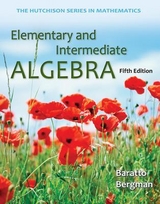
Hutchison's Elementary and Intermediate Algebra
McGraw-Hill Professional (Verlag)
978-0-07-735012-3 (ISBN)
- Titel erscheint in neuer Auflage
- Artikel merken
Elementary & Intermediate Algebra, 4/e by Baratto/Bergman is part of the latest offerings in the successful Streeter-Hutchison Series in Mathematics. The fourth edition continues the hallmark approach of encouraging the learning of mathematics by focusing its coverage on mastering math through practice. This worktext seeks to provide carefully detailed explanations and accessible pedagogy to introduce beginning and intermediate algebra concepts and put the content in context. The authors use a three-pronged approach (I. Communication, II. Pattern Recognition, and III. Problem Solving) to present the material and stimulate critical thinking skills. Items such as Math Anxiety boxes, Check Yourself exercises, and Activities represent this approach and the underlying philosophy of mastering math through practice. The exercise sets have been expanded, organized, and clearly labeled. Vocational and professional-technical exercises have been added throughout. Repeated exposure to this consistent structure should help advance the student’s skills in relating to mathematics. The book is designed for a combined beginning and intermediate algebra course, or it can be used across two courses, and is appropriate for lecture, learning center, laboratory, or self-paced courses. It is accompanied by numerous useful supplements, including McGraw-Hill’s online homework management system, MathZone.
Stefan began teaching math and science in New York City middle schools. He also taught math at the University of Oregon, Southeast Missouri State University, and York County Technical College. Currently, Stefan is a member of the mathematics faculty at Clackamas Community College where he has found a niche, delighting in the CCC faculty, staff, and students. Stefans own education includes the University of Michigan (BGS, 1988), Brooklyn College (CUNY), and the University of Oregon (MS, 1996). Stefan is currently serving on the AMATYC Executive Board as the organizations Northwest Vice President. He has also been involved with ORMATYC, NEMATYC, NCTM, and the State of Oregon Math Chairs group, as well as other local organizations. He has applied his knowledge of math to various fi elds, using statistics, technology, and web design. More personally, Stefan and his wife, Peggy, try to spend time enjoying the wonders of Oregon and the Pacifi c Northwest. Their activities include scuba diving, self-defense training, and hiking. Barry has enjoyed teaching mathematics to a wide variety of students over the years. He began in the fi eld of adult basic education and moved into the teaching of high school mathematics in 1977. He taught high school math for 11 years, at which point he served as a K-12 mathematics specialist for his county. This work allowed him the opportunity to help promote the emerging NCTM standards in his region. In 1990, Barry began the next portion of his career, having been hired to teach at Clackamas Community College. He maintains a strong interest in the appropriate use of technology and visual models in the learning of mathematics. Throughout the past 32 years, Barry has played an active role in professional organizations. As a member of OCTM, he contributed several articles and activities to the groups journal. He has presented at AMATYC, OCTM, NCTM, ORMATYC, and ICTCM conferences. Barry also served 4 years as an offi cer of ORMATYC and participated on an AMATYC committee to provide feedback to revisions of NCTMs standards. Don began teaching in a preschool while he was an undergraduate. He subsequently taught children with disabilities, adults with disabilities, high school mathematics, and college mathematics. Although each position offered different challenges, it was always breaking a challenging lesson into teachable components that he most enjoyed. It was at Clackamas Community College that he found his professional niche. The community college allowed him to focus on teaching within a department that constantly challenged faculty and students to expect more. Under the guidance of Jim Streeter, Don learned to present his approach to teaching in the form of a textbook. Don has also been an active member of many professional organizations. He has been president of ORMATYC, AMATYC committee chair, and ACM curriculum committee member. He has presented at AMATYC, ORMATYC, AACC, MAA, ICTCM, and a variety of other conferences. Above all, he encourages you to be involved, whether as a teacher or as a learner. Whether discussing curricula at a professional meeting or homework in a cafeteria, it is the process of communicating an idea that helps one to clarify it.
0 Prealgebra Review0.1 A Review of Fractions0.2 Real Numbers0.3 Adding and Subtracting Real Numbers0.4 Multiplying and Dividing Real Numbers0.5 Exponents and Order of Operation
1 From Arithmetic to Algebra1.1 Transition to Algebra1.2 Evaluating Algebraic Expressions1.3 Adding and Subtracting Algebraic Expressions1.4 Sets
2 Functions and Graphs2.1 Solving Equations by Adding and Subtracting2.2 Solving Equations by Multiplying and Dividing2.3 Combining the Rules to Solve Equations2.4 Literal Equations and Their Applications2.5 Solving Linear Inequalities Using Addition2.6 Solving Linear Inequalities Using Multiplication2.7 Solving Absolute Value Equations (Optional)2.8 Solving Absolute Value Inequalities (Optional)
3 Graphing Linear Functions3.1 Solutions of Equations in Two Variables3.2 The Cartesian Coordinate System3.3 The Graph of a Linear Equation3.4 The Slope of a Line3.5 Forms of Linear Equations3.6 Graphing Linear Inequalities in Two Variables
4 Systems of Linear Equations4.1 Positive Integer Exponents4.2 Zero and Negative Exponents and Scientific Notation4.3 Introduction to Polynomials4.4 Addition and Subtraction of Polynomials4.5 Multiplication of Polynomials and Special Products4.6 Division of Polynomials
5 Exponents and Polynomials5.1 An Introduction to Factoring5.2 Factoring Special Polynomials5.3* Factoring Trinomials: Trial and Error5.4 Factoring Trinomials: The ac method5.5 Strategies in Factoring5.6 Solving Quadratic Equations by Factoring5.7 Problem Solving with Factoring
R A Review of Elementary AlgebraR.1 From Arithmetic to AlgebraR.2 Equations and InequalitiesR.3 Graphs and Linear EquationsR.4 Exponents and PolynomialsR.5 A Beginning Look at FunctionsR.6 Factoring Polynomials
6 Factoring Polynomials6.1 Relations and Functions6.2 Tables and Graphs6.3 Algebra of Functions6.4 Composition of Functions6.5 Substitution and Synthetic Division
7 Radicals and Exponents7.1 Simplifying Rational Expressions7.2 Multiplication and Division of Rational Expressions7.3 Addition and Subtraction of Rational Expressions7.4 Complex Fractions7.5 Solving Rational Expressions7.6 Solving Rational Inequalities
8 Quadratic Functions8.1 Solving Systems of Linear Equations by Graphing8.2 Systems of Equations in Two Variables with Applications8.3 Systems of Linear Equations in Three Variables8.4 Systems of Linear Inequalities in Two Variables8.5 Matrices (Optional)
9 Rational Expressions9.1 Solving Equations in One Variable Graphically9.2 Solving Linear Inequalities in One Variable Graphically9.3 Solving Absolute Value Equations Graphically 9.4 Solving Absolute Value Inequalities Graphically
10 Exponential and Logarithmic Functions10.1 Roots and Radicals10.2 Simplifying Radical Expressions10.3 Operations on Radical Expressions10.4 Solving Radical Equations10.5 Rational Exponents10.6 Complex Numbers
11 Quadratic Functions11.1 Solving Quadratic Equations by Completing the Square11.2 The Quadratic Formula11.3 An Introduction to the Parabola11.4 Solving Quadratic Inequalities
12 Conic Sections12.1 Conic Sections and the Circle12.2 Ellipses12.3 Hyperbolas
13 Exponential and Logarithmic Functions13.1 Inverse Relations and Functions13.2 Exponential Functions13.3 Logarithmic Functions13.4 Properties of Logarithms13.5 Logarithmic and Exponential EquationsAppendix AAppendix A.1 Determinants and Cramer's Rule
| Erscheint lt. Verlag | 16.4.2010 |
|---|---|
| Sprache | englisch |
| Maße | 216 x 274 mm |
| Gewicht | 2679 g |
| Themenwelt | Mathematik / Informatik ► Mathematik ► Algebra |
| ISBN-10 | 0-07-735012-X / 007735012X |
| ISBN-13 | 978-0-07-735012-3 / 9780077350123 |
| Zustand | Neuware |
| Informationen gemäß Produktsicherheitsverordnung (GPSR) | |
| Haben Sie eine Frage zum Produkt? |
aus dem Bereich



